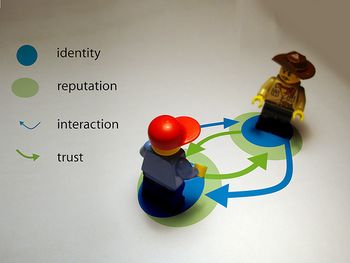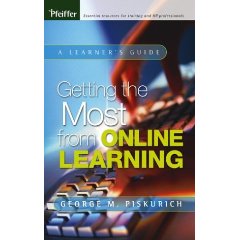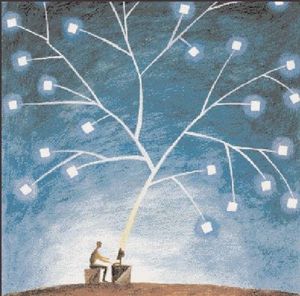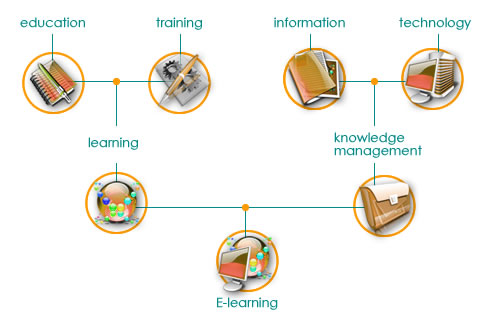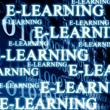(Group 1)-- Corinne, Adam, Danielle, LiAnn
Contents
e-Learning: Place or Pace?
Team members: Corinne, Adam, Danielle, LiAnn
Overview
Problem statement:
With advancing technology comes new opportunities for individuals. The realm of education has not been unique in this aspect of advancing technology. As e-learning becomes more prominent in today's world; what does it mean for the student, instructor and traditional 'brick and mortar' institutions?
Learning Styles
Everyone is unique and learns in different ways. The three main learning styles are; auditory, visual and kinesthetic. This can be broken down into listening, speaking, reading, seeing and doing. Most of e-learning is done through reading text, listening to audio clips and looking at graphics. Therefore you do not get as much hands on work or social interaction. You must be a very self directed learner in order to stay on top off all the learning and homework that you have. Many online learners say they learn more from online classes than from traditional classroom settings. Many e-learning sites now have learning style tests for their learners to take in order to give them the proper materials to target their learning preferences. E-learning is self-paced. The more advanced learners can do their courses quickly and save time whereas the novices can take their time to really learn and understand the material they are covering.
Access to Resources
Online courses are becoming more and more popular, there are 15 campuses spread out over Alberta that offer e-learning, some of those campuses being in Calgary are; Bow Valley College, SAIT and Mount Royal College. Tricia Donovan, executive director of eCampus Alberta states “we are very pleased that eCampus Alberta continues to provide increased access for learners.” New courses and programs are being offered online every year to keep up with the demand. The courses follow a ‘lead and partner model’, which is where the lead institution offers the course and provides the instructions and materials and the partner institution provides support services, such as access to the library, research and study skills support for extra resources. The University of Phoenix is another online school which also provides near by campuses across North America. While taking an online course, additional resources can be found on the campus, on internet search websites as well as by emailing your instructor for a further explanation.
Social Interaction
Dealing with social interaction, E-Learning can have many advantages and disadvantages.
E-Learning is helpful to students who participate more through online interaction, rather than through a reserved face to face interaction. Online learning can be effective for students who actively participate and ask questions. For instance, this would be a useful aspect for shy students who can sometimes be intimidated by face to face contact. Professors can also respond quickly to questions through a variety of ways, such as email, message boards and discussion threads. This makes communicating convenient and effective.
A disadvantage would be the lack of Face-to-Face Interaction between professor and student. Many professors can tell if their students understood the material covered in class by their facial expressions. If they show a face filled with confusion and uncertainty, the professor knows to go over the material again. On E-learning, it is difficult for the professor to tell how his/her student is responding. Another disadvantage is the interaction students have between other students. Many students learn from one another and help each other when problems arise in class. For E-learning, it is harder for students to communicate with one another. Questions may be asked, but nothing can fully replace real-life interaction. As a result, students do not get to hear other student’s opinions and the professor’s real-life interpretations.
Cheating is a major concern for E-learning because professors are oblivious to whether or not students are cheating. With online learning, it is extremely difficult to tell if a student is cheating. For example, in a normal classroom, professors usually have invigilators scan the room while students write an exam in case an individual decides to cheat. With E-learning, students are internationally located, making it impossible to see if they are cheating or not.
Social Interaction is fundamentally a human need and value. They are valuable in learning because if students have difficulties, they can share their feelings to other students which might have the same feelings as well. People learn from one another, and by being simultaneously engaged in a difficult learning task, they can turn to one another for advice, support and encouragement. Classroom learning provides a dynamic and flexible learning environment that allows better communication through discussions, hard-to-anticipate questions to be answered and extra-examples to be presented. When compared to E-learning strategies, even the most superlative system cannot simulate real-life class room and its rich learning environment.
Flexibility
E-learning is the collection of teaching to further education which is available at any time and any place and is delivered to learners electronically. With advances in technology, flexibility is no longer an issue for people who require it. E-learning is designed to meet the concerns of individuals by providing them with increased choice and convenience. It operates to suit the learner by giving them choices about where, when, and how learning occurs. E-learning provides flexibility to individuals who have complicated schedules and daily routines. It is made for independent individuals who want to expand their knowledge and learning skills.
With E-learning, time is not a problem. The flexibility in E-learning allows many students freedom to start at any time and place; and follows his/her own progression according to personal needs for combining studies with work, family and social life. Unlike classroom lectures, individuals can access E-learning whenever they choose, making it easier for them, given no restrictions to learn material at a specific date and time.
E-learning is a type of asynchronous technology; meaning that information is learnt through the use of on-line websites. This indicates that E-learning is beneficially made for long distance learning. This system is designed to deliver education to students who are not physically on location; where communication between professors and students can be accomplished through exchanging printed or electronic media. E-learning also significantly reduces costs for students. Without the need to travel, pay for tuition and student residences, E-learning makes it much more affordable to learn while minimizing costs. Therefore, E-learning allows students to attend courses across physical, political, and economic boundaries but at the same time, it greatly reducing costs for education as well.
E-learning is also made to assist the physically disabled. It makes it much easier for them to learn with no travelling distances between them and the school. All they would need is a computer, which they can access at any time and place. As a result, E-learning provides them access to the learning resources within their own personal space.
Overall, E-learning is extremely efficient for individuals who have difficulty with time constraints. It is effective for independent learners who want to expand their limits on learning and education. E-learning is also helpful for international students who are not physically on-site. Furthermore, E-learning is affordable and cost efficient for students.
Cost
One thing that every student thinks about when enrolling in a post-secondary institution is the cost of attending. The common myth is that online education is drastically cheaper than traditional institutions. This is an understandable misunderstanding. At traditional institutions there are added costs such as building upkeep and support staff. These costs are mostly eliminated at a strictly online institution.
At the University of Calgary, to obtain a bachelors degree majoring in political science in 2008, it would cost a student $23,505.96 in tuition, general fees and GST at five courses a semester over four years. This assumes tuition will not increase over the proposed four years.
If the same student were to enroll at the University of Athabasca majoring in political science, in 2008, it would cost that student $25,666.00 in tuition and GST.
While online learning eliminates some costs, meaning general fees, the cost of convenience is higher. Costs vary at the University of Calgary depending on the number of courses the student is enrolled in, in any given semester. At the University of Athabasca the student would pay a flat rate per course regardless of the number of courses enrolled in.
Outside of the cost of tuition and fees paid to the university, there is also the cost of books. This is something that can drastically increase the cost of traditional 'brick and mortar' institutions as online universities also have most, if not all, of their course materials online.
In the end, the costs of traditional institutions versus online institutions is relatively comparable.
Recognition of Online Degrees
Online courses are gaining acceptance in traditional higher learning institutions, high schools and business organizations. From the Ivy League to small community colleges and now some high schools, a majority of higher education institutions report that online learning provides better than traditional, face-to-face classroom instruction. Although this greater acceptance seems to occur there is still an essential hierarchy of degree recognition from professional employers. This being said however there is no viable information to indicate that any employer would completely disregard the acquisition of an online degree. The fact that there is not a wide array of programs available from strictly online institutions places a limitation as to how employers will recognize these online degrees. There seems to be a greater recognition of mixed degrees versus strictly online degrees. These degrees occur when in part a student takes physical courses from an institution as well as online courses offered at the institution. Most employers are looking for not only an education but skills that acquiring the education provides the student; i.e. interacting in a social setting and punctuality. While there is an increased acceptance of degrees acquired through online learning they are not as valued as at least a partial traditionally acquired degree.
Technologies of Online Learning
The field of distance education is at least 150 years old. The University of London External System began granting degrees to students in 1858 allowing access to credentials in higher education to common citizens. Evolution of the system advanced through the 20th century and included correspondence lectures for British POWs in both World Wars. Later, many recognized institutions offered university equivalency courses to be completed via air mail. Television has been widely used to broadcast courses both locally and via satellite. Today, often a blended approach using print media as well as online instruction, assignment submission and testing is employed to bring data and visualization to the e-learner.
The internet has revolutionized distance education, and the way in which much of online learning is being viewed and accepted has matured. The nature of communication technology as well as student media habits and skills in general has provided guidance to leaders in the field to examine the ‘transformative nature’ of online learning across higher education. Change in online education is a function of shifts in attitudes, technology and educational innovation.
Technological advancement introduces new skills for both students and faculty to acquire. Facilitation and moderation of wikis, blogs, forums, and edu-casts are common. Other technologies, such as peer-to-peer file sharing where data may be partnered and harvested by various users; graphic conferencing, used for collaborative and interactive lectures; and any number of audio and video applications add complexity and convenience to e-learning experiences. Program composition is also a key consideration. The emerging field of professional instructional design is concerned with producing and publishing logical online learning methodologies for a wide audience. The trend is development of high quality comprehensive courses through collaboration of Subject Matter Experts (SMEs), instructional designers and media specialists.
While diverse fields of study are available to most of the population, it is still difficult to simulate laboratories, equipment, and other hands-on requirements of certain fields. It is estimated by some authorities that by 2015, virtual education in most, if not all, disciplines will be a significant part of main-stream learning.
Last Thoughts
While flexibility and convenience are cited as the main reasons that students choose e-learning, it is not for everyone and certainly formal institutional credentials are better recognized by society. There is, however, a large population in the e-learning community who choose the format because it suits them and their lives. Often older, employed learners or those requiring specialized professional training in addition to a traditional ecucation are the focus.
Creating a community in online learning is a stream in and of itself within online learning research. The key is often a combination of instructional design, strong facilitation skills of faculty, and student participation. Technology continuously reduces the gap between students and instructors, access to materials and interaction, time availability and time management.
References
- http://www.londonexternal.ac.uk/150/index.shtml London External 150th Anniversary article
- http://ed-cast.org/] Educational pod-cast repository
- http://cde.athabascau.ca/online_book/ch5.html Terry Anderson is an internationally acclaimed researcher – and went to UofC
- http://www.geocities.com/ok_bcurt/ISDallabout.htm Instructional Systems Design: What it's all about by Curtis L. Broderick
- http://hosted.mediasite.com/hosted5/Viewer/?peid=8886aafee0a444bca4f5acdb063dbd0a Educause Conference 2008
- Tricia Donovan PhD,Executive Director,E-campus Alberta
- http://www.jofde.ca/index.php/jde/index Journal of Distance Education
- http://www.aptitudemedia.com/ Basic elearning model
- http://www.elearnity.com/EKCLoad.htm?load=ByKey/DWIN6FJKGH European Independent Learning Analysis
- http://www.campustechnology.com/article.aspx?aid=48807 Campus Technology magazine
- http://www.sdc.uwo.ca/learning/index.html?styles
- http://www.members.shaw.ca/priscillatheroux/styles.html
- http://www.worldwidelearn.com/elearning-essentials/learning-styles.htm
- http://www.e-learningguru.com/articles/art1_3.htm
- http://www.ecampusalberta.ca/
- http://www.phoenix.edu/
- http://www.itdl.org/Journal/Mar_05/article06.htm
- http://www.jite.org/documents/Vol5/v5p201-219Smart54.pdf
- http://www.spjc.cc.fl.us/eagle/research/beep/beep30.pdf
- http://portal.acm.org/citation.cfm?id=344454
- http://wcm2.ucalgary.ca/registrar/tuitioncost
- http://www.askau.ca/index.jsp?requestType=NormalRequest&source=4&id=52&question=What%20are%20your%20fees
- http://insidehighered.com/views/2008/11/06/overman
- http://www.elearners.com/resources/elearning-faq.asp
- http://www.shareresults.com/local_affiliate_desc.php?mid=2266
- http://www.campustechnology.com/article.aspx?aid=48807
- http://findarticles.com/p/articles/mi_m0MNT/is_8_56/ai_90512523
- http://www.ispi.org/pdf/suggestedReading/Grensing_Pophal.pdf
- http://www.elearnity.com/EKCLoad.htm?load=ByKey/DWIN6FJKGH
- http://www.e-learningguru.com/articles/art1_9.htm
- http://www.unb.ca/naweb/proceedings/2003/PosterNjagiIsbell.html
- ftp://fas.sfu.ca/pub/cs/theses/1997/ChristianPantelMSc.pdf
- http://www.igi-pub.com/journals/IJWLTTbrochure.pdf
- http://www.cs.ualberta.ca/~zaiane/postscript/CATE2001.pdf
- http://www.hrmanagement.gc.ca/gol/hrmanagement/site.nsf/en/hr11560.html
- http://www.guidetoonlineschools.com/
- http://www.youtube.com/watch?v=1CsMOheG8Vo
- http://en.wikipedia.org/wiki/E-learning
- http://www.e-learningcentre.co.uk/eclipse/vendors/imagegalleries.htm
- http://www.sauder.ubc.ca/AM/Template.cfm?Section=Real_Estate_Division&Template=/TaggedPage/TaggedPageDisplay.cfm&TPLID=22&ContentID=11887




